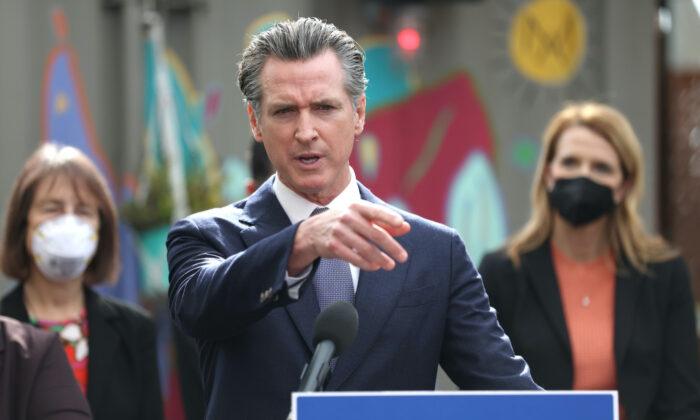Despite calling the program “inflation relief,” Gov. Gavin Newsom’s plan to send California’s middle-class families up to $1,050 this year follows a law that requires the state to refund budget surplus money to taxpayers.
The governor, who is running for re-election this year, took to Twitter to celebrate the Legislature’s passage of the program last month.
“This budget takes immediate actions to give $$ back to millions who are grappling with global inflation and rising costs while tackling some of the greatest challenges of our time,” Newsom’s office wrote on Twitter June 26, adding, “$17 billion in inflation relief is going back to Californians!”
The Gann Limit
The Gann Limit, also known as the State Appropriations Limit, is a constitutional spending cap approved by voters in 1979. Applicable to state and local government spending, the limit is aimed at keeping the state’s spending at its 1978–1979 levels while allowing adjustments based on population and growth in personal income.If the state’s revenues exceed the limit for two years, lawmakers must spend that extra money in certain ways, including returning money to taxpayers and spending more on education.
Cavecche told The Epoch Times the rebate is good, but her organization preferred a proposal to suspend the state’s gas tax.
“We really called for a suspension of the gas tax to give taxpayers in California relief from the inflation,” Cavecche said. “That was our preference and obviously it didn’t go that way.”
In March, a gas tax holiday bill proposed by Republican legislators needed 54 votes to pass but only got 18. Californians are paying $ 0.51 tax per gallon of gas and $ 0.39 per gallon of diesel.
However, Newsom is also finding candid ways to spend on housing, education, rainy-day funding, retirement debt, and other programs, Cavecche said.
Former Sen. John Moorlach, of Orange County, told The Epoch Times Newsom’s idea to reframe the tax rebate was creative but false.
“What he’s saying is, ‘Hey, this is an inflation rebate,’ which is so creative, but it is also false,” Moorlach said. “Gov. Newsom technically has to rebate the money. It isn’t like he’s doing it because he’s Santa Claus.”
Moorlach also questioned the timing with checks issued starting in October, right before Election Day, Nov. 8.
During budget negotiations, Newsom wanted to send every registered vehicle owner in the state a $400 debit card, up to two per person, but Democratic lawmakers wanted to focus the rebate on low- and middle-income families.
Those who did not file tax returns will not be eligible for the refund checks, including many fixed-income seniors and low-income earners.
In California, single residents under 65 with no dependents and who earn $19,310 or less per year don’t need to file taxes. Families with two dependents earning $42,643 or less per year don’t need to file, as well as joint filers 65 or older who make less than $51,524 combined.
Caren Spencer, 76, of Eureka, earns a fixed income of $26,000 a year from Social Security and does not file taxes. She told the Sacramento Bee she was disappointed to find out she would not get a refund.
How Much Will You Get?
Single taxpayers who made $75,000 and couples who filed jointly with $150,000 or less in income in 2020 should expect to receive $350.People with dependents, regardless of how many, will receive an extra $350 per taxpayer. A couple with one or more children who earned a combined $125,000 in 2020 would qualify for $350 each, plus $350, totaling $1050 maximum.
Those who made between $75,000 and $125,000 a year, and couples who earn between $150,000 and $250,000, should see $250, plus the $250 for their dependents for a maximum of $750 per family.
Single people who made between $125,000 and $250,000 and couples who earned between $250,000 and $500,000 annually would receive $200, plus the dependent pay, for a total of $600 per family at most.
Couples who made more than $500,000 and single taxpayers who earned more than $250,000 are not qualified.
The payments will be made by direct bank deposit or debit cards, according to the governor’s office.





